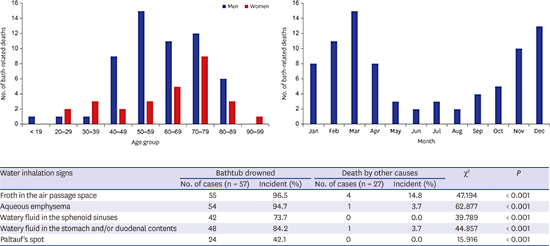1. Geertinger P, Voigt J. Death in the bath. A survey of bathtub deaths in Copenhagen, Denmark, and Gothenburg, Sweden, from 1961 to 1969. J Forensic Med. 1970; 17(4):136–147.
2. Budnick LD, Ross DA. Bathtub-related drownings in the United States, 1979–81. Am J Public Health. 1985; 75(6):630–633.

3. Eren B, Fedakar R, Turkmen N, Akan O. Deaths in the Turkish hamam (hot bath). Bratisl Lek Listy (Tlacene Vyd). 2009; 110(11):697–700.
4. Okuda T, Wang Z, Lapan S, Fowler DR. Bathtub drowning: an 11-year retrospective study in the state of Maryland. Forensic Sci Int. 2015; 253:64–70.

5. Hayashi T, Ago K, Ago M, Ogata M. Bath-related deaths in Kagoshima, the southwest part of Japan. Med Sci Law. 2010; 50(1):11–14.

6. Satoh F, Osawa M, Hasegawa I, Seto Y, Tsuboi A. “Dead in hot bathtub” phenomenon: accidental drowning or natural disease? Am J Forensic Med Pathol. 2013; 34(2):164–168.
7. Suzuki H, Hikiji W, Tanifuji T, Abe N, Fukunaga T. Characteristics of sudden bath-related death investigated by medical examiners in Tokyo, Japan. J Epidemiol. 2015; 25(2):126–132.

8. Suzuki H, Tanifuji T, Abe N, Shibata M, Hikiji W, Fukunaga T. Epidemiology of alcohol-related death while bathing in a bathtub. Nihon Arukoru Yakubutsu Igakkai Zasshi. 2015; 50(2):59–65.
9. Suzuki M, Shimbo T, Ikaga T, Hori S. Sudden death phenomenon while bathing in Japan: mortality data. Circ J. 2017; 81(8):1144–1149.
10. Na JY, Park JP, Park HJ, Lee BW, Choi YS, Seo JS. The statistical analysis on legal autopsy performed in Korea during 2012 year. Korean J Leg Med. 2013; 37(4):198–207.

11. Seo JS, Lee SY, Won KJ, Kim DJ, Sohn DS, Yang KM, et al. Relationship between normal heart size and body indices in Korean. J Korean Med Sci. 2000; 15(6):641–646.

12. Spitz WU, Fisher RS. Spitz and Fisher's Medicolegal Investigation of Death: Guidelines for the Application of Pathology to Crime Investigation. 3rd ed. Springfield, IL: Charles C. Thomas Publishing, Ltd.;1993.
13. Nagasawa Y, Komori S, Sato M, Tsuboi Y, Umetani K, Watanabe Y, et al. Effects of hot bath immersion on autonomic activity and hemodynamics: comparison of the elderly patient and the healthy young. Jpn Circ J. 2001; 65(7):587–592.
14. Yoshioka N, Chiba T, Yamauchi M, Monma T, Yoshizaki K. Forensic consideration of death in the bathtub. Leg Med (Tokyo). 2003; 5:Suppl 1. S375–S381.

15. Chiba T, Yamauchi M, Nishida N, Kaneko T, Yoshizaki K, Yoshioka N. Risk factors of sudden death in the Japanese hot bath in the senior population. Forensic Sci Int. 2005; 149(2-3):151–158.

18. Sengul C, Cevik C, Ozveren O, Sunbul A, Oduncu V, Akgun T, et al. Acute alcohol consumption is associated with increased interatrial electromechanical delay in healthy men. Cardiol J. 2011; 18(6):682–686.

19. Kapusta ND, Tran US, Rockett IR, De Leo D, Naylor CP, Niederkrotenthaler T, et al. Declining autopsy rates and suicide misclassification: a cross-national analysis of 35 countries. Arch Gen Psychiatry. 2011; 68(10):1050–1057.
20. Lawler W. Bodies recovered from water: a personal approach and consideration of difficulties. J Clin Pathol. 1992; 45(8):654–659.









 PDF
PDF Citation
Citation Print
Print






 XML Download
XML Download